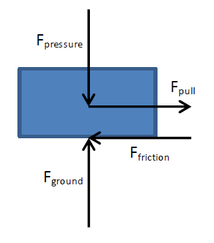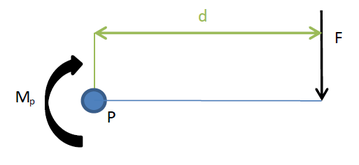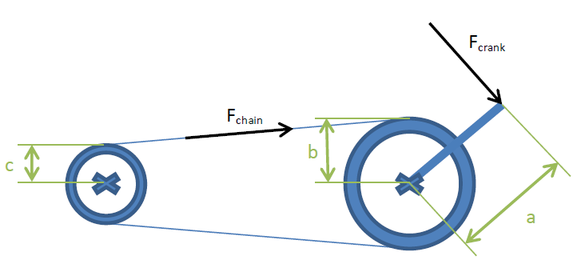This page is trying to address the most common technical questions concerning Bikepolo Bikes (in a rather simple way).
Frame material
Long story short: to build a strong frame, you have to worry about the right tube dimensions rather than about the material. If you compare two frames of equal quality in material and manufacturing, the lighter frame is also the weaker one, generally speaking. It doesn’t matter which material. Aluminium frames are usually built to be lighter than steel frames, hence their reputation of being weaker than steel frames.
Wheels
Bikepolo is all about accelerating and decelerating. Less weight to move means faster acceleration, because of the inertia of mass. Furthermore, rotating mass has an even more important influence on inertia of the whole bike. Here’s why:
Energy stored within the movement of the wheels comes down to:

If normalised to a certain velocity you get E’ which can be used as reference.
The following chart compares inertia moments of different components (per pair):

Add that up, and you get:
Wheelset 1: 700c, 48h, Chukker, 32mm Durano Plus: E’= 7,0 J/(m/s)²
Wheelset 2: 26″, 36h, Mavic XM319, 35mm Kojak, disc brake+guard: E’= 5,24 J/(m/s)² (-34% !)
Given a total weight of the bike of 9kg, inertia of the rest of the bike is 7,2 J/(m/s)², which means that wheelset one has almost as much inertia as the whole rest of the bike. Inertia of the wheels is 3,8 times their actual weight!
In terms of inertia, exchanging wheelset 1 for number 2 (-430g) is like stripping 1,6 kg of the rest of your bike
So, if you want to make your bike lighter, you should definetely start with the wheels. Light wheels will bend easier, which can be a problem for the braking performance of v-brakes. If you use disc brakes, your wheels don’t really need to be straight, as long as they fit through frame and fork.
Light carbon seatposts and stuff might be fancy, but won’t really give you much of an actual advantage.
On the other hand 26″ wheels have a smaller surface than 28″ ones, which means less surface to protect the goal.
But, of course there is more than just theory to think about when comparing 26″ and 700c. Some players find 700c wheels and the typical properties in bike handling suits their style of play better than 26″ wheels.
While I’d personally recommend 26″ wheels at least for smaller frames, 26″ vs. 700c really is a question of belief.
Tyres
Bigger tyres will NOT give you more grip. The only things that count when it comes to grip are:
- the force you apply to the ground
- the pairing of rubber compound and ground surface (comes down to rubber compound, as you mostly can’t influence the ground)
How friction works:

Friction = µ × Pressure
µ is a constant factor defined by the pairing of rubber compound and ground. Tyre surface does not play any role.
A bigger tyre or less pressure and therefore a bigger surface might help you if there is dirt on the court that makes you lose contact with the ground when you ride over it. But, as long as your tyre is in contact with the ground somehow, surface doesn’t matter at all. If you want more grip you basically have one option: use a different tyre (different rubber compound).
Rolling resistance has a minor influence compared to air resistance. A couple of words anyway: rolling resistance increases exponentially as pressure gets lower. If you have lower tyre pressure, your tyre doesn’t just roll in clean contact to the ground, but it gets warped constantly. This needs energy, which is then mostly transfered into heat (“lost” energy).
Pedal strikes
If you have problems with pedal strikes try to get smaller pedals. Using eg. 165mm cranks instead of 170mm will barely have any noticeable effect (increases the maximum pivot angle by not even 1 degree), while getting rid of big bmx pedals will give you up to 7° more leaning before you hit the ground.
Lever concept

M = F × d
The drivetrain of a bike is just a system of connected levers:

Ratio:
Changing your gear will not make you faster just because it’s easier to pedal. Lower gears give you better acceleration and lower top speed, higher gears enable higher top speeds but lower acceleration.
Crank length:
Changing your crank length is exactly like changing your gear. 175mm cranks are easier to pedal but they will not make you faster. While acceleration increases, top speed decreases. If you change from 165mm to 170mm cranks and want to keep your over all ratio, you have to change the chainring or sprocket as well.
The power output of your legs won’t increase just because you change levers in your drivetrain, so that won’t help you to get any faster.
Wheels:
Changing from 26″ to 700c is also just like changing your gear. If you keep your old gear after switching to 26″, you will be slower. That’s because you’ve changed one lever (wheel) without adjusting the other one (e.g. chainring). You have to change the gear as well! If you look closer, even changing the tire size is affecting your over all ratio.
For example: 1.3″ tires + 39/21 = 1.6″ tires + 39/22. 700c + 39/21 = 26″ + 39/19. 175mm cranks + 39/21 = 165mm cranks + 39/22
Trail
Trail gives you a clue (but doesn’t define) how much of a lever the ground has to your wheel. The more trail you have, the higher the so called righting moment gets. This is felt as a more “stable” steering. As the righting moment does not only depend on trail, but also on your HTA, there is no such thing as a perfect trail. Trail is just a value you can easily measure, other than the righting moment. Same trail with different angles will give you different forces.